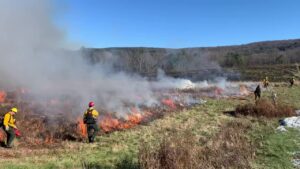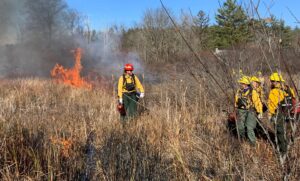Commonly called “the abstracts”, they are out and available in the usual places. The booklet has a cover picture of Daniel Chen, who was recently introduced to angling by MassWildlife staff holding a nice largemouth bass at Lake Chauncy in Westborough.
New regulations for 2023 are as follows:
- Extended pheasant and quail seasons: These seasons now open on the Saturday after Columbus Day and close on December 31. No hunting them during shotgun deer season.
- Expanded hunting implements used on pheasant and quail- stocked WMAs. Hunters can now use all legal methods to hunt game other than pheasants and quail on pheasant and quail- stocked WMAs.
- Extended hunting hours on pheasant and quail- stocked WMAs for certain game. Hunters targeting game other than pheasant and quail on certain WMAs are no longer restricted to hunting from sunrise to sunset.
- There is now a single statewide season for gray squirrel (beginning the Tuesday after Labor Day and ending on the last day of February), and for cottontails and snowshoe hares (beginning the Saturday after Columbus Day and ending the last day of February). The black-tailed jack rabbit season has been eliminated.
Hunters are encouraged to see each species’ page for specific season dates.
Also, certain resident and non-resident fishing, hunting and sporting license fees have been increased as have the pheasant/quail stamps.
Shotgun deer hunting harvest results
As of last Wednesday, hunting conditions were less than ideal. Yes, it was fairly warm Monday and Tuesday, but then the rain moved in on Wednesday. What deer hunters really like is a layer of snow so that they are able to find deer tracks and follow them. I checked with DFW Western District Supervisor Andrew Madden to see how things were going up to that date.
He said, “The week seems to be going well so far. We are about where we were last year at this time. Some of our stations are a little higher and some are a little lower, but overall, pretty good considering conditions are not the best.”
I hope to have a preliminary update after the first full week of the shotgun season in next week’s column.
Prescribed burns
This fall, the Division of Fisheries and Wildlife (MassWildlife), in partnership with The Nature Conservancy (TNC), conducted a prescribed burn at MassWildlife’s Karner Brook Wildlife Management Area (WMA) in Egremont and TNC’s Jug End Preserve, a public recreation area located in the towns of Egremont and Mount Washington, Massachusett. MassWildlife also conducted a prescribed burn at the Fairfield Brook WMA in Richmond, MA. Prescribed fire improves habitat conditions for many common and rare fire-adapted plants and animals found within the wetlands such as fringed gentian, slender cottongrass, American woodcock, native butterflies, and bees. The prescribed fires occurred in late November within prescribed parameters for weather and vegetation including wind, temperature, and fuel moisture.
MassWildlife and TNC have a long history of safely conducting prescribed fires for restoration and
habitat improvement. A prescribed fire can only take place when environmental conditions are right to achieve both safety and ecological restoration goals. Egremont and Richmond fire department officials and air quality regulators at DEP were involved and notified regarding all prescribed fires. These activities were conducted by a specially trained and certified prescribed fire team. MassWildlife supervised the burns with a prescribed fire team from MassWildlife, Mass DCR Forest Fire Control, and The Nature Conservancy.
The Karner Brook and Fairfield Brook wetlands are large and diverse wetland ecosystems composed of marsh, fen, swamp, and open water areas influenced by alkaline ground water. The targeted wetland is known as a calcareous sloping fen and is imperiled in Massachusetts and throughout its entire global range. “Disruption of local hydrologic patterns, flooding by beaver, increases in invasive plants, and discontinuance of certain land use practices such as prescribed fire, have had negative effects within this particular wetland type range wide,” reports MassWildlife’s Senior Restoration Ecologist, Chris Buelow. “Restoring periodic prescribed fire at the right time of year helps keep the fens free of invading trees and shrubs, promotes growth of specialized calcium-loving native plants, and creates habitats needed by wildlife for food, cover, breeding and rearing of young.”
“TNC is partnering with MassWildlife on a large restoration effort at Karner Brook WMA,” says Angela Sirois-Pitel, TNC’s Western Massachusetts Conservation and Restoration Manager. “Wildlife and plants don’t recognize land ownership boundaries and our combined conservation efforts are protecting a critical piece of the Berkshire’s natural and cultural heritage.”
The prescribed fire is funded in part by a grant that MassWildlife received from the EPA’s Housatonic River Natural Resources Damages Fund in 2020. The goal of this project is to restore function and integrity to a suite of calcareous fens in the Housatonic Watershed.
To learn more about:
Calcareous sloping fens in Massachusetts, go to calcareous sloping fen.
MassWildlife’s prescribed fire work, go to Prescribed fire for habitat management | Mass.gov.
TNC’s Berkshire Conservation Work, go to: Berkshire Wildlife Linkage.
Media Contacts: MassWildlife Outreach & Information, Nicole McSweeney, masswildlife.news@mass.gov.
Caren Caljouw, MassWildlife Prescribed Fire Manager, caren.caljouw@mass.gov (508) 439 1070.
“We are thankful to the many partners for helping to make these burns a success.” said Caljouw.
Introduction of BioMap
MassWildlife and TNC recently announced the launch of BioMap, a newly-updated online tool that identifies critical land and waterways throughout the Commonwealth in need of conservation. The web portal delivers the latest scientific data and resources to help state and local governments, land trusts, non-government organizations, and other conservation partners strategically plan projects to conserve wildlife and their habitats.
It combines more than 40 years of rigorously documented rare species and natural community records from MassWildlife with cutting-edge climate resilience data from TNC and spatial data identifying intact fish and wildlife communities, habitats, and ecosystems that are the focus of the Massachusetts State Wildlife Action Plan.
“BioMap is a robust online resource that helps people better understand and appreciate the natural resources in their communities and provides information on where to strategically deploy limited resources to make real and lasting conservation impacts in Massachusetts,” said Department of Fish and Game Commissioner Ron Amidon. “By making an investment in the strategic protection and stewardship of lands, we will better conserve natural areas throughout the state that provide all people with access to nature and outdoor recreation.”
Through BioMap, users can gain a detailed understanding of habitats, species, and resilient landscapes, both locally and across the state. BioMap users can customize data and use the site’s new online Habitat Restoration Resource Center to plan habitat management and land stewardship projects. Additionally, it provides strategies to help communities prepare for, recover from, and adapt to climate change, while bolstering habitat resilience. Taken together, these efforts help to protect the state’s extraordinary biodiversity now and into the future.
“BioMap is more than a map, it is a critical tool that offers a vision for the people of the Commonwealth to come together to strategically protect, manage, and restore lands and waters that are most important for conserving biological diversity in Massachusetts now and well into the future,” said MassWildlife Director Mark Tisa.
A major innovation is the addition of local data to BioMap, which complements statewide habitat information. Habitats assessed from the perspective of each city and town in the Commonwealth will inform local decision making. Furthermore, it includes the latest information on land use in Massachusetts, including a new focus on aquatic environments and habitat restoration tools.
“Massachusetts is home to a wide variety of plants and animals,” said Deb Markowitz, TNC Massachusetts State Director. “Our rich biodiversity is increasingly threatened by habitat loss and fragmentation, climate change, and invasive species. Since its inception, BioMap has become a trusted source of information to guide conservation that is used by a wide spectrum of conservation practitioners. The addition of local data will make BioMap applicable and relevant to many more people and communities, providing opportunities for equitable conservation.”
With similar missions, goals, and science-based approaches to conservation, MassWildlife and TNC are natural partners to produce and maintain BioMap. BioMap received support from the Massachusetts Executive Office of Energy and Environmental Affairs (EEA), DFG, and numerous generous donors. For more information on how to use BioMap or to sign up for technical assistance trainings, contact natural.heritage@mass.gov.


